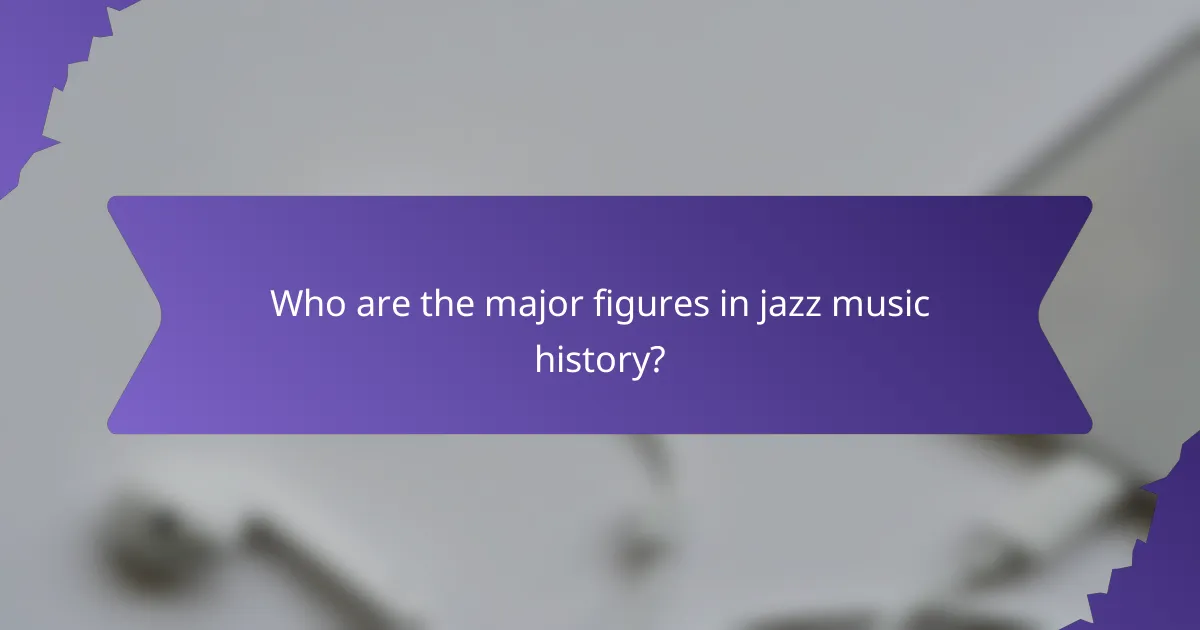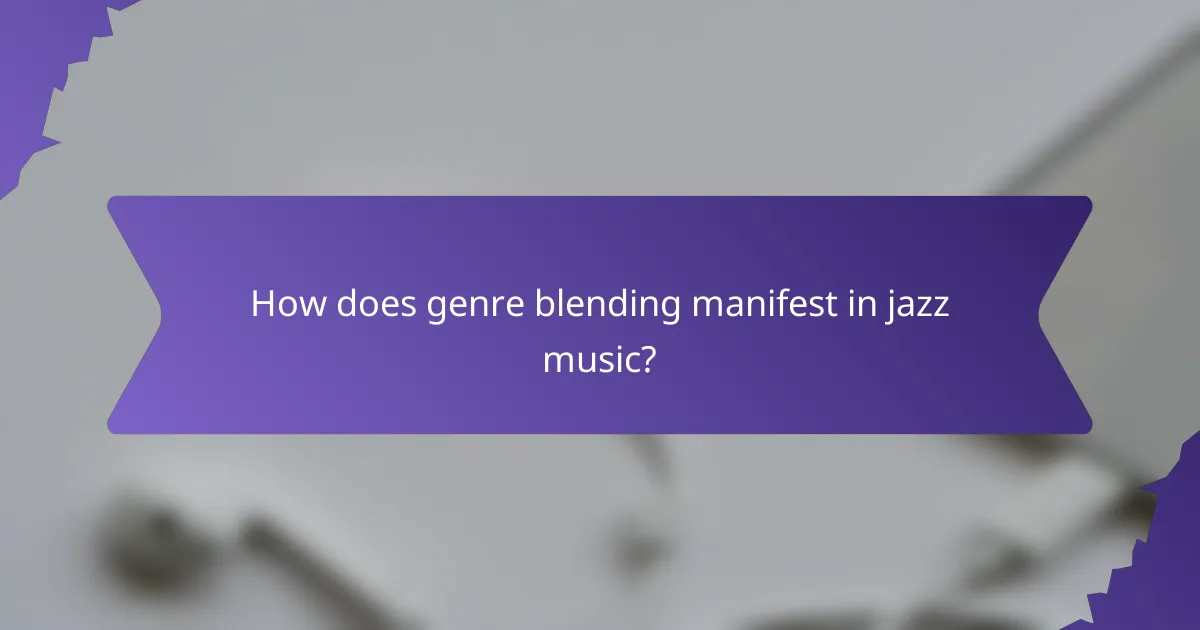Jazz music offers a rich exploration of cultural influences and innovative sounds. This article examines its diverse origins, highlights major figures like Louis Armstrong and Duke Ellington, and discusses genre blending, including jazz fusion. Understanding these elements reveals the dynamic evolution of jazz and its profound impact on music history.

What are the core elements of jazz music?
Jazz music is characterized by improvisation, syncopated rhythms, and a blend of diverse influences. Core elements include swing, blue notes, and call-and-response patterns. Influences from African rhythms, blues, and European harmonies shape its unique sound. Major figures like Louis Armstrong and Duke Ellington contributed significantly to its development, showcasing distinct styles that further enriched the genre. Jazz also incorporates elements from other genres, leading to styles like jazz fusion, which blends rock and jazz elements, highlighting its adaptability and evolution.
How do rhythm and improvisation define jazz?
Rhythm and improvisation are fundamental to jazz, shaping its unique sound. Rhythm provides a driving force, creating a foundation for musical expression. Improvisation allows musicians to explore creativity, making each performance distinct. This combination fosters a dynamic interaction among players, enhancing the genre’s spontaneity and emotional depth. Jazz’s roots in African American musical traditions further emphasize these elements, showcasing their cultural significance.
What role do instruments play in jazz composition?
Instruments play a vital role in jazz composition by shaping its sound and complexity. Each instrument contributes unique textures and rhythms, enhancing improvisation and collaboration. For instance, the piano provides harmonic support, while the saxophone adds melodic expression. The interplay of instruments creates a dynamic environment, allowing musicians to explore various styles and influences. This collaborative aspect of jazz fosters innovation, making it a constantly evolving genre.

Which cultural influences shaped the development of jazz music?
Jazz music was shaped by African American musical traditions, blues, ragtime, and European classical influences. African rhythms and improvisation are foundational elements. The Great Migration brought diverse cultural exchanges, enriching jazz’s development. Notable figures like Louis Armstrong and Duke Ellington further defined the genre, blending styles and expanding its reach.
How did African American traditions contribute to jazz?
African American traditions significantly shaped jazz music through rhythm, improvisation, and cultural storytelling. The call-and-response pattern, rooted in African musical heritage, influenced jazz’s dynamic interaction. Spirituals and blues provided emotional depth and themes, enriching jazz’s expressive capabilities. Key figures like Louis Armstrong and Duke Ellington exemplified this cultural fusion, blending diverse genres and creating a unique sound that reflects African American experiences.
What impact did European music have on jazz evolution?
European music significantly influenced jazz evolution by introducing harmonic structures, rhythmic patterns, and instrumentation. The incorporation of European classical elements shaped jazz’s complexity and diversity. For example, the use of orchestral arrangements and formal compositions enriched jazz’s sound. This blending of styles created unique subgenres, highlighting jazz’s adaptability and cultural fusion. The impact is evident in the works of major figures like Duke Ellington and George Gershwin, who integrated European influences into their compositions, further evolving the genre.
Which regional styles emerged within jazz music?
Several regional styles emerged within jazz music, including New Orleans jazz, Chicago jazz, and West Coast jazz. New Orleans jazz features collective improvisation and a strong rhythmic component. Chicago jazz emphasizes solo performances and a more structured form. West Coast jazz blends cool jazz elements with a laid-back style, often incorporating sophisticated harmonies. Each style reflects the cultural influences and musical innovations of its region, contributing to the rich tapestry of jazz music.

Who are the major figures in jazz music history?
Major figures in jazz music history include Louis Armstrong, Duke Ellington, Charlie Parker, and Miles Davis. These artists shaped the genre through innovation and unique styles.
Louis Armstrong is known for his virtuosic trumpet playing and distinctive voice, revolutionizing jazz with improvisation. Duke Ellington, a prominent bandleader and composer, contributed significantly to jazz orchestration. Charlie Parker, a key figure in bebop, introduced complex harmonies and fast tempos. Miles Davis, known for his innovative approaches, transformed jazz multiple times, from cool jazz to fusion.
These musicians exemplify the diversity within jazz, each bringing unique attributes that influenced the genre’s evolution.
What contributions did Louis Armstrong make to jazz?
Louis Armstrong significantly shaped jazz through his innovative trumpet playing, unique vocal style, and charismatic stage presence. His improvisational skills set new standards for musicianship. Armstrong popularized scat singing, influencing vocal jazz. He collaborated with various artists, blending genres and expanding jazz’s reach. His recordings, such as “What a Wonderful World” and “West End Blues,” remain iconic, showcasing his artistry and emotional depth. Armstrong’s contributions established him as a pivotal figure in jazz history, influencing generations of musicians and transforming the genre.
How did Duke Ellington influence jazz orchestration?
Duke Ellington significantly shaped jazz orchestration through innovative arrangements and a focus on ensemble sound. His use of diverse instrumental combinations and rich harmonies established a unique style that influenced countless musicians.
Ellington emphasized the importance of individual musicians’ voices within the orchestra, allowing for a blend of improvisation and structured composition. His works, such as “Mood Indigo,” showcased his ability to create atmospheric pieces that highlighted the distinct qualities of each instrument.
He pioneered the use of extended forms and sophisticated harmonies, which elevated jazz from dance music to a respected art form. Ellington’s influence persists, as contemporary jazz orchestras continue to draw inspiration from his techniques and concepts.
In what ways did Miles Davis innovate jazz genres?
Miles Davis innovated jazz genres through his unique fusion of styles and groundbreaking techniques. He pioneered cool jazz with “Birth of the Cool,” introduced modal jazz in “Kind of Blue,” and embraced jazz fusion with “Bitches Brew.” His use of silence, space, and unconventional harmonies reshaped jazz’s landscape. Davis’s ability to collaborate with diverse musicians further expanded the genre’s boundaries, making him a pivotal figure in its evolution.

How does genre blending manifest in jazz music?
Genre blending in jazz music manifests through the incorporation of diverse musical elements from various genres. This fusion creates unique subgenres such as jazz fusion, which combines jazz with rock and funk, and smooth jazz, which integrates R&B and pop influences. Notable figures like Miles Davis and Herbie Hancock have played pivotal roles in these innovations, showcasing how jazz evolves by embracing different styles. The result is a rich tapestry of sounds that reflects cultural diversity and musical experimentation.
What are the characteristics of jazz fusion?
Jazz fusion is characterized by the blending of jazz with other genres, particularly rock, funk, and R&B. This genre features complex harmonies, intricate rhythms, and improvisation. Key characteristics include electric instruments, extended solos, and a focus on musicianship. Influential figures like Miles Davis and Weather Report helped define its sound. The genre often incorporates diverse time signatures and a mix of acoustic and electronic sounds, showcasing a unique attribute of innovation within jazz music.
How has jazz influenced pop and rock music?
Jazz has significantly influenced pop and rock music through its improvisational style, complex harmonies, and rhythms. Major figures like Louis Armstrong and Duke Ellington shaped the sound that permeated these genres. The use of syncopation and swing in jazz has been adopted by pop and rock artists, creating a fusion that enhances musical expression. Additionally, jazz’s emphasis on individual artistry has inspired countless musicians to explore their creativity within these genres. The blending of jazz elements into pop and rock has not only expanded their musical boundaries but also enriched their emotional depth.
Which contemporary genres incorporate jazz elements?
Contemporary genres that incorporate jazz elements include hip-hop, R&B, rock, electronic music, and neo-soul. These genres often blend improvisation, complex rhythms, and unique instrumentation characteristic of jazz. For example, hip-hop artists frequently sample jazz records, while neo-soul musicians draw on jazz harmonies and vocal techniques. This fusion enhances musical diversity and showcases jazz’s enduring influence.

What are the unique attributes of specific jazz styles?
Unique attributes of specific jazz styles include distinctive rhythms, improvisational techniques, and cultural influences. For example, bebop features complex harmonies and fast tempos, while smooth jazz emphasizes melodic lines and relaxed grooves. Additionally, fusion jazz blends rock elements with traditional jazz, showcasing electric instruments and diverse genres. Each style contributes to the rich tapestry of jazz music, highlighting its adaptability and evolution.
How does bebop differ from traditional jazz?
Bebop differs from traditional jazz by emphasizing complex harmonies, fast tempos, and improvisation. Traditional jazz often features simpler melodies and structured arrangements. Bebop artists like Charlie Parker and Dizzy Gillespie pushed boundaries, focusing on intricate solos and syncopated rhythms. This shift marked a significant evolution in jazz music, highlighting individual expression over collective performance.
What defines smooth jazz and its audience?
Smooth jazz is defined by its mellow, laid-back sound and improvisational elements. It appeals to a diverse audience seeking relaxation and sophistication. This genre blends jazz with pop, R&B, and funk influences, often featuring smooth melodies and soft instrumentation. Major figures like Kenny G and David Sanborn have shaped its identity, attracting listeners who appreciate a soothing musical experience. The audience typically enjoys the genre in intimate settings, valuing emotional expression and artistic creativity.

Which rare jazz recordings are essential for enthusiasts?
Essential rare jazz recordings for enthusiasts include “The Complete Columbia Album Collection” by Miles Davis, “Thelonious Monk: The Complete Columbia Albums Collection,” and “A Love Supreme” by John Coltrane. These recordings showcase unique attributes like historical significance and artistic innovation. Other noteworthy mentions are “The Amazing Bud Powell” and “Jazz at Massey Hall” featuring iconic figures like Charlie Parker and Dizzy Gillespie. Collectively, these albums represent pivotal moments in jazz history and genre blending.
What makes live jazz performances unique experiences?
Live jazz performances are unique due to their improvisational nature and deep emotional connection. Musicians often respond to each other in real-time, creating a dynamic atmosphere. This spontaneity allows for a fresh experience with every performance. Additionally, the intimate settings of many jazz venues enhance audience engagement, making each concert memorable. The blend of various influences, from blues to classical, further enriches the jazz experience, showcasing the genre’s versatility.
How do rare collaborations shape the jazz landscape?
Rare collaborations significantly enrich the jazz landscape by merging distinct styles and fostering innovation. These partnerships often result in unique soundscapes that challenge traditional boundaries. For instance, collaborations between jazz musicians and artists from genres like hip-hop or classical create new audiences and revive interest in jazz.
Notable examples include the collaboration between Herbie Hancock and Joni Mitchell, which blended jazz with folk elements, resulting in a fresh auditory experience. Such unique collaborations introduce rare attributes to jazz, showcasing versatility and adaptability in the genre. As a result, they not only preserve jazz’s relevance but also expand its creative horizons.

What best practices should aspiring jazz musicians follow?
Aspiring jazz musicians should practice consistently, study jazz theory, and listen to diverse jazz styles. They must also learn from established musicians and collaborate with peers. Regular improvisation enhances creativity and adaptability.
1. Establish a daily practice routine.
2. Study jazz theory and chord progressions.
3. Listen to various jazz recordings.
4. Analyze performances of major figures like Miles Davis and John Coltrane.
5. Collaborate with other musicians to gain new perspectives.
6. Engage in regular improvisation sessions to develop unique voice.
How can musicians effectively practice improvisation?
Musicians can effectively practice improvisation by focusing on listening, experimenting, and applying techniques. Listening to various jazz styles enhances creativity. Experimenting with scales and rhythms fosters spontaneity. Applying techniques from influential jazz figures, like Charlie Parker’s bebop or Miles Davis’s modal approach, enriches improvisational skills. Regular practice sessions and collaboration with other musicians also promote growth in improvisation.
What common mistakes should be avoided in jazz performance?
Common mistakes to avoid in jazz performance include over-reliance on sheet music, neglecting improvisation, and ignoring the importance of listening to other musicians. Players often focus too much on technical skills rather than emotional expression. Additionally, failing to practice regularly can hinder a musician’s ability to adapt in a live setting. Lastly, not understanding the historical context of jazz can limit creativity and authenticity in performance.